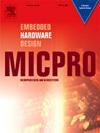Real-time neural network-based thermal stress compensation for pressure sensors in precision localization systems
IF 2.6
4区 计算机科学
Q3 COMPUTER SCIENCE, HARDWARE & ARCHITECTURE
引用次数: 0
Abstract
This article presents a real-time Artificial Intelligence-based Reconfigurable Self-Calibration Unit (AI-ReSCU) for piezoresistive MEMS pressure sensors, designed to mitigate long-term drift effects induced by thermal stress. The system integrates a compact and reconfigurable neural network to dynamically estimate and correct sensor inaccuracies with minimal energy and area overhead. The architecture comprises a trigger module for detecting deviations from nominal behavior and a compensation engine driven by a quantized neural network optimized for hardware efficiency. The network processes temporal input windows and operates using 24-bit activations and 1-bit weights, enabling real-time inference with ultra-low power consumption. The fully digital system was prototyped in STMicroelectronics’ BCD8 technology, occupying 0.55 mm2 and achieving a dynamic power consumption of 4.46 nW under typical conditions, thanks to extensive resource reuse and clock gating strategies. Offline experimental validation on LPS22HH pressure sensors demonstrated the system’s ability to recover up to 1.6 hPa of drift-induced error with a recovery latency of approximately 50 input samples, while maintaining measurement deviations within ±0.5 hPa across multiple stress scenarios.
基于实时神经网络的精密定位系统压力传感器热应力补偿
本文介绍了一种用于压阻式MEMS压力传感器的基于人工智能的实时可重构自校准单元(AI-ReSCU),旨在减轻热应力引起的长期漂移效应。该系统集成了一个紧凑且可重构的神经网络,以最小的能量和面积开销动态估计和纠正传感器的不准确性。该体系结构包括一个用于检测偏离标称行为的触发模块和一个由优化硬件效率的量化神经网络驱动的补偿引擎。该网络处理临时输入窗口,并使用24位激活和1位权重进行操作,从而以超低功耗实现实时推理。全数字系统的原型采用意法半导体的BCD8技术,占地0.55 mm2,在典型条件下,由于广泛的资源重用和时钟门控策略,动态功耗为4.46 nW。在LPS22HH压力传感器上进行的离线实验验证表明,该系统能够恢复高达1.6 hPa的漂移误差,恢复延迟约为50个输入样本,同时在多种应力情况下保持±0.5 hPa的测量偏差。
本文章由计算机程序翻译,如有差异,请以英文原文为准。
求助全文
约1分钟内获得全文
求助全文
来源期刊

Microprocessors and Microsystems
工程技术-工程:电子与电气
CiteScore
6.90
自引率
3.80%
发文量
204
审稿时长
172 days
期刊介绍:
Microprocessors and Microsystems: Embedded Hardware Design (MICPRO) is a journal covering all design and architectural aspects related to embedded systems hardware. This includes different embedded system hardware platforms ranging from custom hardware via reconfigurable systems and application specific processors to general purpose embedded processors. Special emphasis is put on novel complex embedded architectures, such as systems on chip (SoC), systems on a programmable/reconfigurable chip (SoPC) and multi-processor systems on a chip (MPSoC), as well as, their memory and communication methods and structures, such as network-on-chip (NoC).
Design automation of such systems including methodologies, techniques, flows and tools for their design, as well as, novel designs of hardware components fall within the scope of this journal. Novel cyber-physical applications that use embedded systems are also central in this journal. While software is not in the main focus of this journal, methods of hardware/software co-design, as well as, application restructuring and mapping to embedded hardware platforms, that consider interplay between software and hardware components with emphasis on hardware, are also in the journal scope.
 求助内容:
求助内容: 应助结果提醒方式:
应助结果提醒方式:


